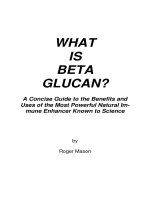Corporate action a concise GUide
Bạn đang xem bản rút gọn của tài liệu. Xem và tải ngay bản đầy đủ của tài liệu tại đây (788.22 KB, 231 trang )
Corporate Actions –
A Concise Guide
An introduction to securities events
by Francis Groves
HARRIMAN HOUSE LTD
3A Penns Road
Petersfield
Hampshire
GU32 2EW
GREAT BRITAIN
Tel: +44 (0)1730 233870
Fax: +44 (0)1730 233880
Email:
Website: www.harriman-house.com
First published in Great Britain in 2008
Copyright © Harriman House Ltd
The right of Francis Groves to be identified as the author has been asserted
in accordance with the Copyright, Design and Patents Act 1988.
978-1-905641-67-3
British Library Cataloguing in Publication Data
A CIP catalogue record for this book can be obtained from the British Library.
All rights reserved; no part of this publication may be reproduced, stored in a retrieval
system, or transmitted in any form or by any means, electronic, mechanical,
photocopying, recording, or otherwise without the prior written permission of the
Publisher. This book may not be lent, resold, hired out or otherwise disposed of by
way of trade in any form of binding or cover other than that in which it is published
without the prior written consent of the Publisher.
Printed and bound in Great Britain by Athenaeum Press Limited, Tyne & Wear.
No responsibility for loss occasioned to any person or corporate body acting or
refraining to act as a result of reading material in this book can be accepted by
the Publisher, by the Author, or by the employer of the Author.
Contents
About the Author
vii
Preface
ix
Introduction
xi
Quick Guide to Locating Information on
Specific Corporate Actions
1. Defining Corporate Actions
xv
1
The characteristics of a share and its issuer – definitions of
corporate actions – how the action is decided upon: articles
of association, AGMs & EGMs – the board of directors –
chief financial officers and treasury departments – legislation
underpinning the system.
2. The Main Corporate Actions
9
How many types of corporate action are there? –
definitions/descriptions of main types of corporate actions
(dividends, scrip dividends, scrip issues, return of capital,
consolidation, rights issues, takeover bids, agreed takeovers,
de-mergers) – benefits or otherwise for shareholders and
share prices.
3. The Corporate Actions Process
31
From the investor’s point of view – announcement dates –
record dates – ex-dates – effective dates – steps along the way
to a takeover – corporate actions information from the share
prices pages – typical timetables for returns of capital and
rights issues.
iii
Corporate Actions – A Concise Guide
4. The Corporate Actions Industry
43
What goes on behind the scenes – chart of the corporate
action flow of information – the connections between the
main players – the legislative framework.
5. How Well is the Corporate Actions System Working?
59
The volume of actions and cost of corporate actions
administration; staff, data and investment – risk and the cost
of mistakes in processing – where do the problems arise? –
who loses out when mistakes are made?
6. Corporate Actions; Technology and the Future
73
The importance of automation in corporate actions – ISO
15022 and SWIFT – Straight Through Processing (STP) – ISO
20022 – solution providers in corporate actions automation
– how likely is it that full standardisation will ever be
achieved?
7. Corporate Actions Wreaking Change on Shares
Corporate actions, a winding path – a concrete example –
how much does the investor need to know? – how important
is corporate action information (or the lack of it) as a factor
in selecting a sharedealing/investment service? – different
routes for information to reach the investor.
iv
87
Contents
8. Shareholder Voting
97
How important is it to vote? – voting by investment funds –
differences between the UK & the USA – the Myners Report
– the state of affairs for the retail/small investor – voting
terminology.
9. Corporate Actions and Taxation
109
Stamp taxes and withholding taxes – illustrations of how
different corporate actions can affect income tax and CGT
liabilities with some specific shares as examples – treatment
of corporate actions for ISA holders – investment funds and
corporate actions
10. Corporate Actions in Different Jurisdictions
121
National differences in corporate actions – Japanese
dividends – depository receipts – restrictions on foreign share
ownership – different rules for shareholder general meetings
– bearer certificates – the removal of corporate actions
barriers in the EU?
11. Corporate Actions for Debt Securities
135
The volume of corporate actions relating to bonds –
fundamental difference from equity corporate actions –
interest and redemption, the basic corporate actions –
optional redemption, callable and puttable bonds – variable
coupon bonds and floating rate notes – conversions and
warrants.
v
12. Corporate Action Effects Across the Investing Spectrum
147
How corporate actions affect the calculation of stock
exchange indices – how charts handle corporate actions – the
effects of corporate actions on futures, options, CFDs and
ETFs – corporate actions for CDOs – corporate actions and
securities lending – hedge funds and corporate actions –
corporate actions and the pension fund trustee – corporate
actions and crime.
13. Conclusion
161
Glossary
165
Appendices
191
List of Central Securities Depositories
193
Capital Gains Tax Example – Biffa/Severn Trent
197
Non-rights Issues of Shares
199
Suggested Reading
201
Index
205
About the Author
Francis Groves studied modern history at the London School of
Economics and has many years of experience working for legal and
financial publishers including, Reuters, the Financial Times and
Butterworths. He has written on overseas property investment and
created financial literacy training materials. The interaction of politics
and finance is a particular interest for him.
vii
Preface
What the book covers
Corporate actions are normally considered as incidental to the business
of investing and marketing investments, but the aim of this concise
guide is to look at the subject of corporate actions in the round, defining
what corporate actions are, listing and describing the main corporate
actions and showing how individual corporate actions are applied to
investors’ holdings of securities. This will give an overview of the way
in which the corporate actions processing function works both in the
UK and other important global markets. Detailing all the differences
between jurisdictions is beyond the scope of this guide, though the UK
is taken as a starting point to help describe and explain significant
national distinctions, particularly for the United States and the rest of
the European Union.
Who the book is for
The guide is designed to be an introduction to corporate actions for
investment industry practitioners in general. Those starting out in
corporate actions processing will find it a helpful outline, but it is also
designed to be useful for all who encounter corporate actions
tangentially in disciplines such as fund management or financial advice
provision. Different industry participants have differing interests in
corporate actions, and for the sake of consistency the guide is (mainly)
written from the point of view of the beneficial owners of securities.
ix
Corporate Actions – A Concise Guide
How the book is structured
Those who simply require a handy and straightforward introduction
to specific corporate actions will find the quick guide to the content
and the glossary of corporate actions terms especially useful.
The first three chapters deal exclusively with equity corporate actions.
These chapters cover definitions of a corporate action and the legal
framework(s) underpinning corporate actions, followed by a look at
the most significant actions one by one, and then a detailed examination
of the staging of some of these. The corporate actions of debt securities
are given separate treatment in Chapter 11.
In Chapters 4, 5 and 6 the focus moves from the corporate actions
themselves to the industry that has grown up to process them. These
three chapters cover respectively the corporate actions industry, its
efficiency and its progress (recent and future).
Chapter 7 looks at the impact of successive corporate actions on one
particular share (Encore Oil) and shareholdings in it. This is followed
by a look at the scope investors have for influencing such events through
shareholder voting.
The final chapter looks at how corporate actions are treated in the
context of stock indices, stock charts and a number of more complex
investments.
Although change in the corporate actions industry is sometimes slow (it
has been described as glacial) the process is always evolving, and so this
guide can only aim to be a snapshot of the state of affairs at the time of
writing, together with an outline of some of the forces for change that
are at work. The aim has been to provide sufficient detail to give the
reader a working model that is practically helpful in navigating the
corporate actions universe.
x
Introduction
Corporate actions have been sidelined for too long and deserve to be
treated with more respect. No type of investment security can be fully
understood without knowledge of its corporate actions. All corporate
actions have implications for the sustainability of an investment’s
performance, but more beguiling investment preoccupations put them
into the shade.
The corporate actions processing industry is in deeper shadow than
even the actions themselves. Together with bank clearing and exchange
settlement systems, the administration of corporate actions is one of
the key co-operative functions tying our highly competitive global
finance industry together. In the financial markets of the developed
world the efficiency and “risklessness” of corporate actions processing
is entirely taken for granted. Yet the volume of complex corporate
actions and a common sense estimate of the likelihood of mistakes
occurring suggest that industry practitioners and investing clients may
be deluding themselves.
Figures for the annual number of equity and debt security corporate
actions stand at approximately one million and three million
respectively.1 For equities it is estimated that corporate actions that can
be classed as complex comprise 10-15% of the total. It has also been
estimated that every year 18,000 corporate actions have the potential
to cause significant share price movements in the world’s 25 most
1
For the 12 months from March 2003 there were estimated to be 935,000 equity corporate actions
(‘Corporate Action Processing, What Are The Risks’, a study carried out by the consultancy Oxera
on behalf of the Depository Trust and Clearing Corporation. Figures on the volume of complex
actions and those with the potential to cause share price movements are from the same report.
xi
Corporate Actions – A Concise Guide
important stock markets. Although this represents just a small
percentage of the total number of corporate actions, it nevertheless
equates to several dozen price moving corporate events each trading
day. In the realm of debt securities the payment events of structured
debt caused a huge increase in the volume and complexity of corporate
actions in the 2003-07 period.2 Corporate actions processing faces
challenges in delivering entitlements to investors accurately and in good
time and meeting these challenges is important to the securities industry.
Despite this corporate action practitioners have been left to themselves,
carrying on their craft quietly behind a high wall.
If knowledge of corporate actions brings us to fully understand the
securities they relate to, some familiarity with corporate actions
processing is important in gaining an insight into the workings of the
securities industry as a system. With the exceptions of accountancy and
financial regulation, no other activity involves as many kinds of
investment industry participant as corporate actions processing.
The current state of corporate actions underscores the incompleteness
of the globalisation of financial markets. The corporate actions industry
is global in the sense that the corporate actions for any tradable security,
from wherever it originates will, in some cases, only be processed after
a fashion. The relegation of corporate action processing to obscurity is
one factor in disguising the host of cultural, ethical and regulatory
differences that distinguish securities markets from one another. These
differences in the detail are woven into much cross-border corporate
actions processing. Although we may be on the brink of an unparalleled
extension of the world’s developed economies, understanding of the
entitlements of shareholders (domestic and overseas) in the newly
developed countries is a long way behind other features of globalisation.
2
‘Transforming Structured Securities Processing’, (Depository Trust & Clearing Corporation
white paper, September 2007).
xii
Introduction
A look at corporate actions at this time will give food for thought in
several directions. As the financial institutions take stock, re-examining
their points of reference, it will be interesting to see whether corporate
action entitlements receive more of the limelight than they have up until
now.
The corporate actions industry needs to improve its efficiency; what
needs to change to affect this, and will the major players be able or
willing to put up the investment necessary? As the balance of economic
power shifts eastwards, what kind of corporate actions environment
will investors meet with when they invest outside their own region? In
sum, a better acquaintance with the current state of corporate actions
will allow a greater understanding of changes in the securities industry.
xiii
Quick Guide to Locating
Information on Specific
Corporate Actions
Quick Guide to Locating Information on Specific Corporate Actions
Corporate Action
Where to look
Related Topics
Bonus Issue (Scrip Issue,
Capitalisation Issue, Stock
split)
Chs.2,3
Share Consolidation Ch.2
Consolidation
Chs. 2,7
Conversion
Ch.11
Dividend Yield Ch.2
Dividends
Chs.2,3,10
Dividend Cover Ch.2
Scrip Dividend Ch.2
Interest Payments
Ch.11
Redemption
Ch.11
Return of Capital
(Capital Distribution)
Chs.2,3
Capital Gains Tax Ch.9
Rights Issue
(Share Placing)
Chs.2,3
Other types of share
placing Ch.7,
Appendix llll
Dilution Ch.7
Capital Gains Tax Ch.9
Pre-emption Rights Ch.2,
Appendix lll
Scrip Dividends
Ch.2
Share Buyback
Ch.2
Takeover Bid
Chs.2,3,5,8,
Voting
Chs.8,10
Warrant
Ch.11
Accrued Interest Ch.11
Partial Redemption Ch.11
Drawing Ch.11
Agreed Takeover Ch.2
De-merger/Divestment
/Spin off Chs.2,8,9
Reverse Takeover Chs.7,8
Capital Gains Tax Ch.9
xvii
1.
Defining Corporate Actions
I
nvestors may focus mainly on the purchase of securities and their resale but equities and debt securities are more than passive tokens of
investment value. By means of corporate actions they acquire a life of
their own, an ability to transform themselves and to make investors
change their minds. Individual corporate actions for equities such as
takeover bids or rights issues can have a significant effect on share
prices. Over just a few years, the cumulative effect of a number of
corporate actions can cause a share to undergo a complete
metamorphosis.
The starting point of all corporate actions is the ownership of individual
units of investment; shares, bonds or variations. For shares of common
stock, the type of security on which we shall be concentrating chiefly,
the overarching right is that of ownership of the company in question
(the issuer) and from ownership spring the following specific rights:
1. To elect the board of directors
2. To vote for corporate actions that require shareholder approval
3. To share in corporate earnings in the form of dividends
4. To maintain the same proportion of the company’s common stock
in the event of additional shares being issued
And, finally,
5. To receive a share of the residual assets of the company in the event
of liquidation (which could be called the saddest corporate action
of them all)
So, along with ownership come shared control, shared benefits and
rules to protect the rights attached to each share. The shared control
tends not to translate into power for the small investor or even large
3
Corporate Actions – A Concise Guide
minority shareholdings and rules protecting the rights attached to each
of a company’s shares do not necessarily protect the financial interests
of the share’s owner.3
Further definitions
Definitions of “corporate action” vary depending upon whether the
point of view is that of the issuer:
‘an event initiated by a company that affects its share,’ (Frances
Maguire, The Banker 1st June 2007)
‘A corporate action occurs when changes are made to the capital
structure or financial position of an issuer of a security that affect any
of the securities it has issued.’ (‘Transforming Corporate Action
Processing’, Depository Trust & Clearing Corporation, 2003)
or the shareholder:
…where the owner of a security is given the opportunity to receive
a benefit or participate in a reorganisation of the company.
A complete definition covering all types of corporate action may not
be possible. The important point is that corporate actions all have their
genesis in the entitlements that accompany owning the shares (no
matter how few of them). It follows from this that, in order to put
corporate actions into effect, comprehensive information about the
ownership of all the shares concerned is required. This information is
held in the company’s share register.
3
The shareholder’s lack of control over events affecting their investment will be looked at in more
detail in Chapter 7.
4
Defining Corporate Actions
How are corporate actions decided?
For each company the workings of corporate actions will be set out in
the articles of association. If one thought of a company as a country, the
memorandum and articles of association would be the country’s
constitution, the shares would be the voters and the place of Congress
or Parliament would be taken by the shareholder meetings (annual or
extraordinary general meetings). Although this looks like a “winner
takes all” system of government, some proposals, known as “special
resolutions”, require 75% support.4 Proposals to change the
memorandum and articles of association would be treated as special
resolutions.
Chapter 8 will take another look at voting in shareholder meetings;
how it works, how effective it is and moves afoot to improve the system.
Decisions on corporate actions or changes to the articles of association
are not the only purpose of shareholder meetings; they also (for
example) vote to approve the remuneration of directors, to elect
directors, or re-elect them when their terms of office expire.
In the analogy of a country the directors are, of course, the government.
In almost all circumstances it is they who make proposals on various
corporate actions for the shareholder meetings to decide on.
Generally speaking, ensuring that a company has sufficient capital and
cash to carry on its business successfully will be the responsibility of
the company’s Chief Financial Officer (CFO) and its treasury
department. Recommendations about items such as the dividend, share
or bond issues and share buybacks will originate from this quarter.
4
The significance of the 75% hurdle for special resolutions was demonstrated at the Northern
Rock EGM in January 2008 when a number of rebel resolutions received the support of the simple
majorities of shareholders represented, but failed because support fell short of the 75% level. As
a rule, reporting on shareholder meetings in the press is strong on comment and short on detail.
The most detailed source of information is likely to be the website of the company in question.
5
Corporate Actions – A Concise Guide
Patterns of organisation and chains of command vary from one
company to the next, but a company’s annual report should explain
how the treasury function is carried out.
Who writes the rules?
The picture of the sovereignty of shareholder meetings over the affairs
of the company distorts reality by ignoring the importance of national
(and international) legislation in regulating companies’ affairs. In the
United Kingdom legislation in the form of Statutory Instruments (SIs)
taking one or other of the various companies acts or other statutes as
their authority have an all important effect on companies’ responsibility
for corporate governance generally and corporate actions in particular.
Companies also have to comply with regulation emanating from the
Financial Services Authority (FSA), such as the Combined Code on
Corporate Governance. Increasingly, this legislation and regulation is
itself subject to Europe-wide policies in the form of EU directives.
In the United States, corporation law is mainly a state matter so there can
be variations from one US state to the next. However, the situation is
made simpler by the fact that a large proportion of American companies
are incorporated in the State of Delaware (the state allows out of state
incorporations and does not tax trading activities that take place outside
the state), so Delaware’s General Corporation Law applies to a lot of
US companies.5 In addition, some 16 of the states conform to the Revised
Model Business Corporation Act (1984) either wholly or substantially.6
5
This is available on the web at: . The general
distinction between corporate governance, a state matter, and securities trading, a federal one, has
become less clear cut since the passing of the Sarbanes Oxley-Act in 2002, the biggest incursion
of federal power into corporate law since the 1930s. These variations between the states are more
than cosmetic. For example, states like North Carolina would allow creditors to make claims
against shareholders who had received ‘excessive dividends’, limited liability notwithstanding.
6
6
These include Florida, Georgia, Indiana, Virginia and Washington.









